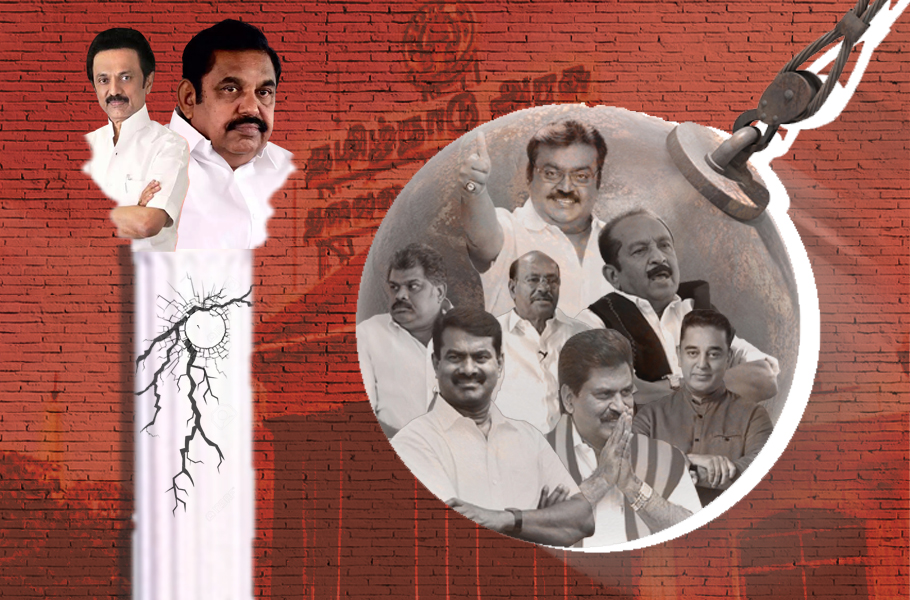
TN voting puzzle: ‘Second best choice' and scare in Dravidian parties
It is not a rule that the second-best choice always wins. In general, what has been observed is that the second-best alternative is more likely to emerge as a strong consensus contender.

It is not a rule that the second-best choice always wins. In general, what has been observed is that the second-best alternative is more likely to emerge as a strong consensus contender. An interesting historical anecdote for this was the story of the Afghan rebels and their war against the then USSR. (Something which is also briefly mentioned in MNM chief Kamal Haasan’s movie Vishwaroopam).
The CIA-funded Afghanistan’s war against the then Soviet Union through multiple theatres that included Pakistan’s ISI (Inter-Services Intelligence). Hamid Gul, the then head of ISI, had backed one of the seven major Afghan tribal chiefs, Gulbuddin Hekmatyar.
Hekmatyar failed in the long run, but not for the lack of support or money. General Gul got Stinger missiles from the CIA and gave them to Hekmatyar who sold them onwards till they ended up with arch-enemy Iran.
Author Lawrence Wright once asked Gul: “Why did you favour Hekmatyar?” He replied: “I went to each of the seven (warlords), and I said, ‘I know you are the strongest, but who is No. 2?’ They all said Hekmatyar!”
Tamil Nadu is one of the states with a number of small political parties. According to the ECI data, TN has nearly 75 parties. And other than the national parties and the communists, these parties also comprise groups that represent the Dravidian ideology, caste and religious sections. In most cases, the voting public, in general, does not even know the existence of so many parties because when these smaller parties are accommodated into the Dravidian alliance, they invariably contest not on the symbol of their party, but on the symbol of the Dravidian majors.
Tamil Nadu, for the first time in decades of Dravidian politics, came out with an organized third front in 2016, the People’s Welfare Front (PWF) which was formed in October 2015 as a grand political alliance. It initially consisted of four parties — Marumalarchi Dravida Munnetra Kazhagam (MDMK), Viduthalai Chiruthaigal Katchi (VCK), Communist Party of India (CPI) and Communist Party of India (Marxist) (CPI-M). The alliance contested the 2016 Tamil Nadu and Puducherry assembly elections as one unit. The alliance rejected a potential alliance with the Congress, BJP, DMK or the AIADMK and wanted to pitch itself as the ‘next best alternative’.
The alliance led movements against price rise, atrocities against minorities and Dalits and efforts to curtail freedom of speech. It had taken a strong position in favour of prohibition in Tamil Nadu. Later it made an electoral alliance with DMDK and Tamil Maanila Congress.
Pockets of influence of smaller parties
Most of these small parties had concentrated votes; the Left for example, had considerable influence in industrial and trade belts. Another example is Coimbatore and Tirupur; this was because of the decades of presence of trade union movements in these places.
Similarly, other parties such as the TMC, MDMK and VCK had their specific pockets of influence. The attempt of the third front was to consolidate their base in these pockets and challenge the hegemony of Dravidian parties.
The alliance did not win a seat, but did influence the outcome of elections: in nearly 91 of the 234 constituencies that it contested, the votes it obtained were more than the victory margins. In 56 of these constituencies, the AIADMK emerged the winner and in the remaining seats, the DMK won.
One can conclude that the six-party alliance failed to create any major impact in terms of seats other than being a spoiler in many constituencies that were considered ‘safe’. The DMDK and TMC (M) later walked out of the alliance after the poll debacle.
The PWF ceased to exist in 2016 following differences between MDMK and the rest over Prime Minister Narendra Modi’s demonetization scheme. The Vaiko-led MDMK walked out of PWF, an alliance shaped by it in 2015. Vaiko’s support to Modi’s demonetization did not go down well as the other three parties were fiercely opposed to it. Thus a unique experiment in Tamil Nadu politics ended.
From the booth-level data, one can conclude that as things stand now, the idea of a third front is a bogey, yet it, if at all it is formed, can do significant damage to the Dravidian parties. That’s the reason why Dravidian majors scurry to accommodate parties into their alliance to pre-empt the “second best” alternative emerging as a threat, if not now, maybe in the future.
(This is third part of this series on Tamil Nadu politics. Read the first part here and the second part here)


